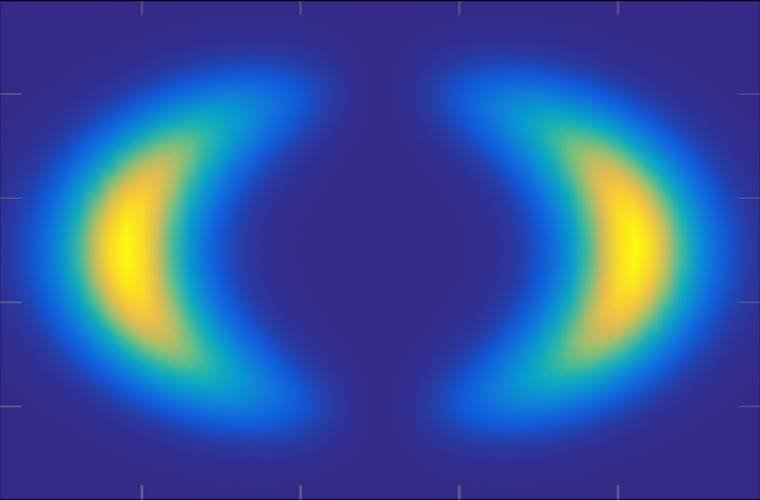(Updated 08/12/21: Additional comments from Dr. White have been added to this article.)
Warp drive pioneer and former NASA warp drive specialist Dr. Harold G “Sonny” White has reported the discovery of an actual, real-world “Warp Bubble.” And, according to White, this first of its kind breakthrough by his Limitless Space Institute (LSI) team sets a new starting point for those trying to manufacture a full-sized, warp-capable spacecraft.
In an interview, White added that “our detailed numerical analysis of our custom Casimir cavities helped us identify a real and manufacturable nano/microstructure that is predicted to generate a negative vacuum energy density such that it would manifest a real nanoscale warp bubble, not an analog, but the real thing.” In other words, a warp bubble structure will manifest under these specific conditions. White cautioned that this does not mean we are near building a fully functioning warp drive, as much more science needs to be done (Updated 08/12/21).
“To be clear, our finding is not a warp bubble analog, it is a real, albeit humble and tiny, warp bubble,” White told The Debrief, “hence the significance.”


THEORETICAL WARP DRIVES AND SCIENCE VISIONARIES
In 1994, Mexican Mathematician Miguel Alcubierre proposed the first mathematically valid solution to the warp drive. More specifically, he outlined a spacecraft propulsion system previously only envisioned in science fiction that can traverse the cosmos above the speed of light without violating currently accepted laws of physics.
That solution was lauded for its elegant mathematics, yet simultaneously derided for its use of theoretical materials and massive amounts of energy that appeared virtually impossible to engineer in any practical way.
Over a decade later, this theory underwent a major shift, when Dr. White, a then NASA-employed warp drive specialist and the founder of the highly respected Eagleworks laboratory, reworked Alcubierre’s original metric and put it into canonical form. This change in design dramatically reduced the exotic materials and energy requirements of the original concept, seemingly providing researchers and science fiction fans alike at least a glimmer of hope that a real-world warp drive may one day become a reality. It also resulted in the informal renaming of the original theoretical design, a concept now more commonly referred to as the “Alcubierre/White Warp Drive.”
Since then, The Debrief has covered a number of physicists and engineers taking their own stabs at designing a viable warp drive, including an entire group of international researchers working on a warp drive that requires no exotic matter. However, like Alcubierre and White before them, the warp concepts of these would-be visionaries all still remain theoretical in nature.
Now, it appears the situation has changed.
TIMING IS EVERYTHING, ESPECIALLY AT WARP SPEED
It is often said that timing is everything. Therefore, it is not surprising that back when Dr. White began his latest DARPA-funded research into custom Casimir cavities (a unique, micro-scale structure with all types of promising applications), he definitely did not expect to stumble upon this potentially historic discovery, particularly one supporting a theoretical concept that has often defined his public persona.
“Some work we’ve been doing for DARPA Defense Science Office is the study of some custom Casimir cavity geometries,” explained White at the American Institute of Aeronautics and Astronautics (AIAA) Propulsion Energy Forum in August of 2021, an event attended by The Debrief. “In the process of doing that work, we kind of made an accidental discovery.”
Without going into the complicated physics behind Casimir cavities and the tantalizing quantum-scale forces often observed in these unusual structures, it suffices to say that they are in no way related to warp drive theory or mechanics. At least, they never had been before. But, says White, it is work that he and his LSI team are passionate about, and something DARPA believes has a number of possible applications.
So, whether by pure coincidence or some sort of personal destiny, it appears that one of the handful of engineers on the planet who would immediately know what it was he was looking at when conducting his Casimir cavity research was in the exact right place at the exact right time to notice a striking similarity to his warp drive passion project and his current research, an observation that may have otherwise gone unseen.
“I think this is a great example of sometimes you are doing work for one reason, and you find something else you really didn’t expect to find,” said White at the AIAA conference.
Therefore, in this particular case at least, it seems that timing was indeed everything.
PEER REVIEW AND CONFIRMATION OF WARP BUBBLE
“While conducting analysis related to a DARPA-funded project to evaluate possible structure of the energy density present in a Casimir cavity as predicted by the dynamic vacuum model,” reads the actual findings published in the peer-reviewed European Physical Journal, “a micro/nano-scale structure has been discovered that predicts negative energy density distribution that closely matches requirements for the Alcubierre metric.”
Or put more simply, as White did in a recent email to The Debrief, “To my knowledge, this is the first paper in the peer-reviewed literature that proposes a realizable nano-structure that is predicted to manifest a real, albeit humble, warp bubble.”
This fortuitous finding, says White, not only confirms the predicted “toroidal” structure and negative energy aspects of a warp bubble, but also resulted in potential pathways he and other researchers can follow when trying to design, and one day actually construct, a real-world warp-capable spacecraft.
“This is a potential structure we can propose to the community that one could build that will generate a negative vacuum energy density distribution that is very similar to what’s required for an Alcubierre space warp,” explained White.


A PROPOSED PATH FORWARD
To further evaluate his groundbreaking results and move the research forward, White and his team have come up with a proposed design for a testable, nano-scale “warp drive craft.”
“Specifically,” said White during the AIAA presentation, “a toy model consisting of a 1-micron diameter sphere centrally located in a 4-micron diameter cylinder was analyzed to show a three-dimensional Casimir energy density that correlates well with the Alcubierre warp metric requirements.”
“This qualitative correlation,” he adds, “would suggest that chip-scale experiments might be explored to attempt to measure tiny signatures illustrative of the presence of the conjectured phenomenon: a real, albeit humble, warp bubble.”
White expanded further on that idea in yet another email to The Debrief.
“This is a potential structure we can propose to the community that one could build that will generate a negative vacuum energy density distribution that is very similar to what’s required for an Alcubierre space warp.”
When asked by The Debrief in December if his team has built and tested this proposed nano-scale warp craft design since that August announcement, or if they have plans to do so, White said, “We have not manufactured the one-micron sphere in the middle of a 4-micron cylinder.” However, he noted, if the LSI team were to undertake that at some point, “we’d probably use a nanoscribe GT 3D printer that prints at the nanometer scale.” In short, they have the means, now they just need the opportunity.
There is “no plan to do this currently,” explained White, as “we are laser-focused on the custom Casimir cavities.”
Nonetheless, after proposing this further path for future research, White and his team have also outlined a second testable experiment that involves stringing a number of these Casimir-created warp bubbles in a chain-like configuration. This design, he said, would allow researchers to better understand the physics of the warp bubble structure already created, as well as how a craft may one day traverse actual space inside such a warp bubble.
“We could go through an examination of the optical properties as a result of these little, nano-scale warp bubbles,” explained White at the AIAA conference. “Aggregating a large number of them in a row, we can increase the magnitude of the effect so we can see (and study) it.”


CRAWL, WALK, RUN
Given that DARPA is paying the LSI Eagleworks lab to explore Casimir cavities and not the accidental discovery of a warp bubble, regardless of its potentially staggering implications (at least, not yet), it is not surprising that White and his team remain “laser-focused” on the work at hand. Plus, given the sometimes secretive nature of work funded by groups like DARPA, even if White and his team were planning to conduct the two tests outlined once their current project is completed, it may not be immediately made public until another significant breakthrough is cleared for publication.
(Note: White confirmed to The Debrief that the current DARPA-funded research is not classified, hence his freedom to publish the warp bubble result. However, the normally forthcoming researcher was more tight-lipped when asked whether or not any future, potentially DARPA-funded work on a nano-scale warp bubble spacecraft might be in the offing once this current work is finished.)
In the end, especially given the magnitude of this discovery and its potential implications, White believes it is only a matter of time before his mini-warp craft is designed and tested, a milestone that he believes will slowly but surely move the whole process toward the ultimate goal of a warp-capable spacecraft.
“This discovery allows us to identify a real structure that can be manufactured that will manifest a real warp bubble,” White explained to The Debrief.
When asked by The Debrief how quickly a successfully-tested nano-scale “craft” like the experimental one his team proposed could be scaled up to something that can actually be flown in space, he offered a more realistic approach to this research, along with an almost poetic piece of hard-earned advice.
“It is early to ask questions about some type of actual flight experiment,” said White. “In my mind, step one is to just explore the underlying science at the nano/micro scale,” before moving toward a larger craft.
Or put more simply, as White did to end that same email, “Crawl, walk, run.”
(Editor’s Note: An update was issued to this article on 08/12/21 to rectify that Dr. White has discovered a structure within his Casimir study that would theoretically manifest a warp bubble under laboratory conditions. The headline was also changed to reflect this update. Since the time of publication, White has also provided additional statements to other media outlets that appear to conflict with some of the original statements he provided to The Debrief for this article.)
Follow and connect with author Christopher Plain on Twitter: @plain_fiction

